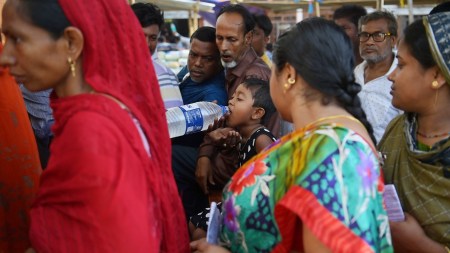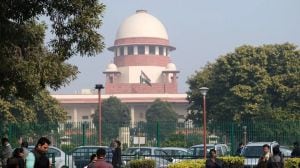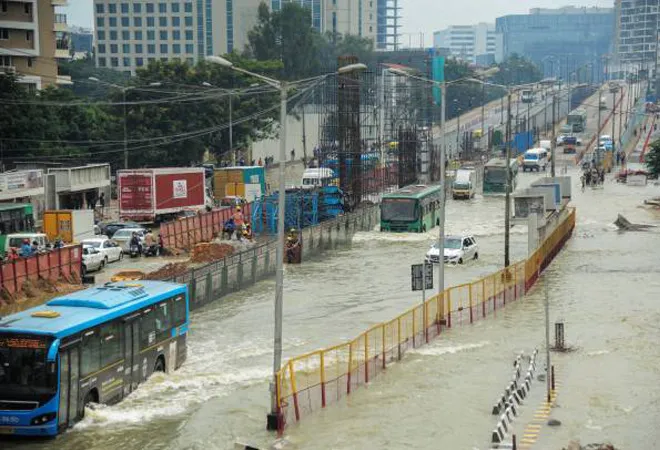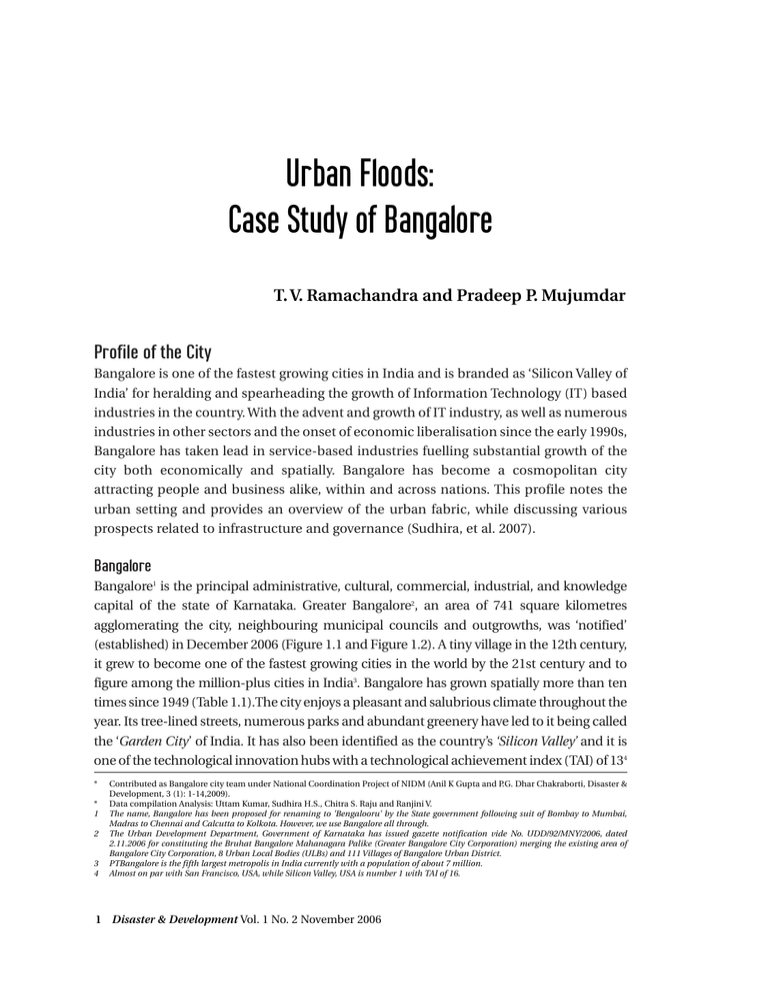Strategies for the future
Strategy to incorporate Integrated Storm Water Management (ISWM) approach to flood management integrating land and water resources development in a lake catchment or river basin, within the context of integrated water resources management, and aims to maximize the net benefit from floodplains and to minimize loss to life from flooding. This is based on
- a participatory approach involving users, planners and policy-makers at all levels and should be open, transparent, inclusive and communicative.
- Decentralization of decision-making is necessary, with full public consultation and involvement of stakeholders in planning and implementation.
- Coordination at the highest level to promote coordination and cooperation across functional and administrative boundaries needs to be ensured.
- Land use planning and water management are combined in one synthesized plan, through coordination of land and water management authorities to achieve consistency in planning.
- Clearing all encroachments that come in the way of the storm water drain network in the city.
- Restoring all lakes. Removal of all encroachments in lake catchments
- Declaring 500 m around the lake as no activity zone
- Aligning the drain network and checking blockage and overflowing of drains.
- Reviewing existing storm water drains, ensuring connectivity of primary, secondary and tertiary drains.
Redesigning for current load conditions along with building barriers between roads and open drains at crossings.
Thus, an integrated approach to stormwater management maintains the traditional function of minimising flooding, in addition to integration of water quantity and quality management policies and practices with the coordinated, total catchment approach to the issues of stormwater management. In addition to flood management, a primary goal is to protect downstream water bodies from contamination and erosion, while maintaining, or in some cases re-establishing, natural waterways and wetland features as part of the drainage network. The location and design of significant stormwater management infrastructure (e.g. drainage corridors, culverts, etc.) is to be based on a firm understanding of the local needs/values, legislative requirements and practical constraints considering the hydraulic, hydrologic, environmental, economic, social, legal and practical aspects. For example, maintaining or improving the natural conditions of a waterway in Bangalore (i.e., widening and grading the banks) instead of channelising and concreting, could bring multiple benefits including flood mitigation, water quality improvement by vegetation and recreational benefits. Suggested strategic actions are outlined in Table 10 .
Table 10 – Strategic Actions
The storm water system consists of many natural water-bodies and a high-density waterway system. Sewage contamination leading to eutrophication of waterbodies would result in a major health and socio-economic disaster for the city. Some receiving waterbodies have no major outlets and pollutants are accumulated in the sediment deposits. Litter, discarded building materials, sediments and other solid waste items are the main causes of blockages of the drainage system resulting in flooding in some pockets of Bangalore.
The objective of Catchment and Storm water Management Plan is to integrate all water quality, quantity and waterways issues from a catchment perspective to enhance and stabilise degraded waterways, minimise flood risk, maximise amenity and property values and improve water quality in the stormwater system with the following objectives:
- Prevention of raw sewage from entering the stormwater system;
- Promotion of best management practices to improve stormwater quality;
- Management of storm water drainage ensuring the protection of waterways, water quality and minimising floods;
- Integration of water quality management with flooding and waterway corridor management issues;
- Design and implementation of flood mitigation schemes (where necessary) to minimise the impacts of large flood events and potential damage costs;
- Mapping and monitoring of flood prone areas and flood levels along the waterways under appropriate Average Recurrent Interval storms through drainage and flood studies. Based on the designated flood levels along the main waterway system, waterway corridors are to be determined and to be incorporated as “no development” areas into the City Comprehensive Development Plan to prevent development within these corridors.
- Alteration in topography in the catchment area to be banned through an appropriate legislative measures;
Academia.edu no longer supports Internet Explorer.
To browse Academia.edu and the wider internet faster and more securely, please take a few seconds to upgrade your browser .
Enter the email address you signed up with and we'll email you a reset link.
- We're Hiring!
- Help Center


URBAN FLOODS IN BENGALURU AND FLOOD MODELS: A REVIEW

2019, IAEME PUBLICATION
The Urbanization consistently affecting various parameters of environment, affecting human activities. Urban flooding is one of the major concerns affecting by urbanization damaging life of people and properties. Bengaluru is marked as Silicon city and a major IT hub, which is facing such issues from past decade due to rapid urbanization. Managing urban flood is a challenging task for environmental as well as for urban planners. It is necessary to utilize or to develop flood model for getting better knowledge about existing issue. A critical review on various studies on Bengaluru flooding and flood models has made, which reveals that urban flooding is majorly due to conversion of permeable surfaces to concrete or bitumen asphalts and encroachment of natural drains. Most of the models based on empirical, conceptual and data driven. This article presents a critical review on some of the practicing flood models and effects of flooding.
Related Papers
IAEME Publication
Urban flood is mostly seen in urban areas. They may be due to heavy rainfall, adverse topographical conditions and anthropogenic factors, lead to destruction of drainage, damage to buildings, and even loss of life and property. Now in order to control such problems, systematic urban flood studies are necessary. This study is focused on the mapping and spatial analysis of urban flood vulnerability in Vrishabhavathi valley watershed, Bengaluru using Analytical Hierarchy Process (AHP), GIS and remote sensing techniques. Few causative factors for flooding considered are rainfall, slope, drainage density, land use, building density, road density, non-existing natural drainage and non-existing Lake. The thematic map of these factors was converted into raster maps. Numerical weight and ranking scores will be assigned to each element factor according to fundamental scale of AHP technique. Urban Flood Vulnerability Zone (UFVZ) map is computed using weighted overlay analysis of GIS technique and classified into five categories, viz., very low, low, moderate, high and very high flood zone classes. UFVZ map was compared with the flood prone locations exist in Bengaluru city to assess the accuracy of result. The plot of flood prone locations on flood vulnerability zone map evident that, 50% of flood prone locations found under moderate flood vulnerability zone. This result depicts the fact that, urban flood vulnerability is highly influenced by anthropogenic factors than natural factors in urban environmental study area. The predicted flood vulnerability zones are found to be in good agreement with known flood prone locations.
As long as human being continues to exists, urbanization continues. Urbanization has a direct effect on environment which in turn effects the variations in hydrology. It may results from changes in the land use pattern to built-up areas resulting in runoff which ultimately leads to flood. Most of the studies revealed that land use pattern has drastically changed in which the built up area increases year after year. The land use land cover changes can be identified using GIS. Many researchers have found that urbanization has an impact on hydrological parameters such as runoff volume, discharge in drains, infiltration, interception, evapotranspiration etc. An attempt has been made to consolidate the review of literature related to impact of urbanization on hydrological parameters
The most commonly used hydrological models for runoff estimation in soft bedrock, is the Soil Conservation Service Curve Number (SCS-CN) model. For a heterogeneous geomorphic land form the model may limit its applicability. Therefore, the SCS-CN model is tested to a small watershed, Udaygiri mandal of Nellore district, Andhra Pradesh. A linear regression method was employed to quantify the SCS-CN model performance. SCS-CN method estimation was evaluated with the help of runoff data, simulated data and actual rainfall data. It was found an accuracy of R2=0.966 for a 5 years (2012-2016) rainfall data.
IAEME PUBLICATION
Mostly populous city like Chennai is subjected to frequent pluvial and fluvial flooding in low-lying areas. The factors attributed to flooding are due to its complex nature of natural and anthropogenic factors such as insufficient capacity of the local drainage system, high intense rainfall associated with cyclonic activity, the highly impervious area which leads to block the runoff to drain into the river. To address these issues of flooding, a need is felt to focus on the magnitudes of flooding and how to mitigate flood from occurrence. Therefore, a study has been conducted on Central Buckingham canal watershed to develop a coupled 1D and 2D numeric model for assessing the flood extent and flood depth From the model results, the simulated flood depth showed good agreement against the observed flood depth at known outlets. Finally, as a part of flood mitigation measures, revised storm water drainage system which enhances the flood carrying capacity of the drains which results in less inundated area which solves the problem of urban flooding have been implemented. After adopting the measure, the study shows the watershed is free from flooding which makes the flow into the channels without any blockades.
In arid and semiarid regions, limited water resources is one of the constraints for agricultural activities and urban development. The eastern region of Wasit Province, Iraq suffer from a severe shortage of water resources especially the cities of Badra, Jassan and Zurbatiya. A few studies was focused on the streams that originate in Iraq-Iran borders such as Galal Badra, Tursekh and Swena as important source of water for domestic and agricultural use. This study was investigated the quality and quantity of water and better management desired lake because store the water in Shweicha Wetland decrease the quantity and quality of water.
In arid and semiarid regions, limited water resources is one of the constraints for agricultural activities and urban development. The eastern region of Wasit Province, Iraq suffer from a severe shortage of water resources especially the cities of Badra, Jassan and Zurbatiya. A few studies was focused on the streams that originate in Iraq-Iran borders such as Galal Badra, Tursekh and Swena as important source of water for domestic and agricultural use. This study was investigated the quality and quantity of water and better management of the streams which discharges into Shweicha Wetland. The Digital Elevation Models (DEMs) of Shuttle Radar Topography Mission (SRTM), the land use/cover of Landsat classified images by The National Geomatics Center of China, the soil dataset of Food and Agriculture Organization of UN (FAO), and the weather dataset of Climate Forecast System Reanalysis (CFSR) were applied into the Soil and Water Assessment Tool (SWAT) model, the model was ran for the period from 1/1/2000 to 31/12/2013 on daily time step of simulation. Due to lack in observed data such as flow or sediment the model was not calibrated with ± 20% error in prediction. From the results, the area of Shweicha Watershed is 21355 〖km〗^2 , 59.6% of this area inside Iraqi borders the remained in Iranian borders. According to the model prediction, the average income of surface runoff entered to Shweicha Wetland for the simulation period was about 5.5 m^3/sec with maximum peak of 5510 m^3/sec on 29/1/2013 and the simulated sediment yield from the region of study is highly related to the peak amount of surface runoff. The region considered, highly sediment production because the barren land dominate 43% of the total watershed’s area. Finally, it is recommended to store water before entered to Shweicha Wetland and find best way to prevent deposition
The concept of sustainable agricultural management is essentially adoption of soil and water conservation practices in the agricultural land. The aims of these practices are proper land use, protecting land against all forms of deterioration, building and maintaining soil fertility, conserving water for form use, proper management of local water for drainage, flood protection and sediment reduction and increasing productivity from all land uses. The study area Kothapally Agricultural land is located in Kothapally village (longitude 78 0 5' to 78 o 8'E and latitude 17 o 20' to 17 o 24'N) in Ranga Reddy district, which is 47 km from the Hyderabad. It covers 507 ha of which 467 ha are cultivated and rest of 40 ha are wasteland, the water shed is characterized by an undulating topography with an average slope of about 2.5%. The broad objective of the present study is to estimate the daily runoff from the rainfall data using SCS-CN (Soil Conservation Service-Curve Number) method. The data of daily, monthly, and yearly rainfall, temperature, relative humidity, wind speed, evaporation data of 11 years data from 2006-2016, was collected from the ARI (Agricultural Research Institute, Rajendra Nagar), Hyderabad. The present study area involves collection of service data like satellite data, survey of India topo-sheets, and prepares various thematic maps like base map, contour map, drainage map, soil map, slope map, land use/ land cover map are prepared by using survey of India topo-sheets and satellite imageries. Soil map, study area map, drainage maps are prepared. The methodology is used for the analysis of data is the Soil Conservation Service-Curve Number (SCS-CN) of computation of runoff for the sustainable agricultural fields.
The NRCS-CN equation for flood predictions relies on the value of the Curve Number and the amount of rainfall event to determine the corresponding runoff. Usually, the curve number value (CN value) is extracted from the tables that follow United State land features classification which might not be applicable to the land features in Saudi Arabia. This research paper doesn't use NRCS-CN table values form of the US for estimating the curve number value, rather, the CN values have been estimated from the data of rainfall and runoff events of some gauged watersheds in the western region of Saudi Arabia (Yiba watershed and its sub-basins). The observed CN values are in the range of 61 and 99. For the 1984-1987 rainfall events, the CN behavior follows the standard regime with an approached value, of 52. It has also been shown that there is a relatively good agreement between the observed CN and the theoretical NRCS-CN curves with the factor of initial abstraction (λ = 0.2). The watershed morphometric characteristics have an effect on the value of the curve number. Some parameters give a strong relation with the average CN such as basin average elevation, shape factor, basin slope, basin Length, and watershed area where R 2 (i.e., R-Square which known as the coefficient of determination) is 0.99, 0.81, 0.87, 0.78 and 0.56 respectively within some range of the specified parameter given in each equation. These relationships could be used to estimate average curve numbers for similar basins without relying on NRCS-CN tables.
Water management has become one of the major concerns in many countries. Researchers have proposed different criteria and methodologies for identification of suitable dam sites. Based on our literature review, we have identified three major methodologies for selection of suitable dam site location: Geographic Information System and Remote Sensing (GIS/RS), Hydrological Modelling with GIS/RS and Multi-criteria Analysis (MCA) integrated with HM and GIS/RS. Advantages and disadvantages of each of the methodologies are also mentioned. These methods consider different criteria ranging from those based on only biophysical characteristics to more integrated criteria including socioeconomic criteria. Most common criteria used for the selection of suitable dam site were slope, rainfall, land cover, soil type and distance to settlement/road/stream. When more relevant criteria were considered, the suitability site selection tended to be more reliable and accurate. Hence MCA plays an important role.
The Soil Conservation Service Curve Number (SCS-CN) method is widely used for predicting direct runoff volume for a given rainfall event. The applicability of the SCS-CN method and the runoff generation mechanism were thoroughly analysed in a Mediterranean experimental watershed in Hyderabad. The region is characterized by a Mediterranean semi-arid climate. A detailed land cover and soil survey using remote sensing and GIS techniques, showed that the watershed is dominated by coarse soils with high hydraulic conductivities, whereas a smaller part is covered with medium textured soils and impervious surfaces. The analysis indicated that the SCS-CN method fails to pre direct runoff for the storm events studied, and that there is a strong correlation between the CN values obtained from measured runoff and the rainfall depth. The hypothesis that this correlation could be attributed to the existence of an impermeable part in a very permeable watershed was examined in depth, by developing a numerical simulation water flow model for predicting surface runoff generated from each of the three 15 soil types of the watershed. The results support the validity of this hypothesis for most of the events examined where the linear runoff formula provides better results than the SCS-CN method. The runoff coefficient of this formula can be taken equal to the percentage of the impervious area. However, the linear formula should be applied with caution in case of 20 extreme events with very high rainfall intensities. In this case, the medium textured soils may significantly contribute to the total runoff and the linear formula may significantly underestimate the runoff produced.
RELATED PAPERS
Dr. Sunny Agarwal
Juan Piedra Espinosa
eSAT Journals
IJIRST - International Journal for Innovative Research in Science and Technology
Jonathan Chang
Blue Eyes Intelligence Engineering and Sciences Publication
Aminuddin Ab Ghani , Lai Hin
mojtaba hooshyary , farhad hooshyaripor
International Journal of Machine Tools & Manufacture
santanu das
IAEME Pubblication
Clement Wilson
David Havlick
jorge leandro , Joao P. Leitao
RELATED TOPICS
- We're Hiring!
- Help Center
- Find new research papers in:
- Health Sciences
- Earth Sciences
- Cognitive Science
- Mathematics
- Computer Science
- Academia ©2024
Understanding Urban Floods as Extreme Events and Disaster Management: A Case Study of Bengaluru
- First Online: 18 January 2023
Cite this chapter

- Sonal Bindal 7 ,
- Sandipan Samanta 8 &
- Anil Kumar Gupta 7
Part of the book series: Society of Earth Scientists Series ((SESS))
318 Accesses
Flooding is by far the most natural hazards, affecting the greatest number of people on the planet. Severe floods in urban areas have become more common in recent years as a result of uncontrolled urbanisation and climate change, and this trend is expected to continue in the coming years. Climate change is constantly changing the weather pattern. There has been rise in annual average temperature, which has affected the variation of sea-land surface temperature. Thus, leading to change in the monsoon pattern over Indian ocean and Indian Sub-continent. Now-a-days, it is usually experienced with increase in number of summer days and lesser winter days. The monsoon system of the Indian Subcontinent is greatly affected by Indian Ocean and due to changing pattern, shorter rainfall period having higher intensity rainfall for very short period of time leading to occurrence of extreme rainfall events over isolated areas. This leads to the condition of sudden disaster like situation in urban agglomeration where due to poor water drainage structure the situation has been occurring more frequently. The results identify 18% of total area is liable to urban floods out of which 10% area indicates high risk, 50% area shows medium risk and remaining 34% area falls under low risk of flooding. Thus, making an alarm to an urban man-made disaster due to heavy rainfall in urban areas. Due to human involvement in the environment, there have been a dominance over the natural components leading to change in rainfall pattern.
This is a preview of subscription content, log in via an institution to check access.
Access this chapter
- Available as PDF
- Read on any device
- Instant download
- Own it forever
- Available as EPUB and PDF
- Compact, lightweight edition
- Dispatched in 3 to 5 business days
- Free shipping worldwide - see info
- Durable hardcover edition
Tax calculation will be finalised at checkout
Purchases are for personal use only
Institutional subscriptions
Ali H, Mishra V, Pai DS (2014) Observed and projected urban extreme rainfall events in India. J Geophys Res Atmos 119(22):12–621
Article Google Scholar
Bhandiwad R (2015) Variability of rainfall in Bangalore city - mapping of hourly variation of heavy rainfall event. Am Int J Res Sci Technol Eng Math (AIJRSTEM) 15–160:124–139
Google Scholar
Centre for Research on the Epidemiology of Disasters UNISDR (2015) The human cost of weather related disasters 1995–2015. https://www.unisdr.org/we/inform/publications/46796 Accessed Dec 2018
Chithra SV, Nair MH, Amarnath A, Anjana NS (2015) Impacts of impervious surfaces on the environment. Int J Eng Sci Invention 4(5):27–31
EM-DAT, CRED (2015) Centre for Research on the Epidemiology of Disasters. The International Disaster Database. Available online www.emdat.be . Accessed 6 Feb 2019
Goswami BN, Venugopal V, Sengupta D, Madhusoodanan MS, Xavier PK (2006) Increasing trend of extreme rain events over India in a warming environment. Science 314(5804):1442–1445
Article ADS CAS Google Scholar
Goyal MK (2016) Engineering hydrology. PHI Learning Pvt. Ltd., Delhi
Guhathakurta P, Sreejith OP, Menon PA (2011) Impact of climate change on extreme rainfall events and flood risk in India. J Earth Syst Sci 120(3):359–373
Article ADS Google Scholar
Gupta AK, Nair SS (2011) Urban floods in Bangalore and Chennai: risk management challenges and lessons for sustainable urban ecology. Curr Sci 100:1638–1645
IPCC (2007) Impacts, adaptation and vulnerability. Contribution of Working Group II to the fourth assessment report of the Intergovernmental Panel on Climate Change, 976
Khaladkar RM, Mahajan PN, Kulkarni JR (2009) Alarming rise in the number and intensity of extreme point rainfall events over the Indian region under climate change scenario. Indian Institute of Tropical Meteorology. Research Report no. RR-123
Kripalani RH, Kumar P (2004) Northeast monsoon rainfall variability over south peninsular India vis-à-vis the Indian Ocean dipole mode. Int J Climatol 24(10):1267–1282
Kumar P, Geneletti D, Nagendra H (2016) Spatial assessment of climate change vulnerability at city scale: a study in Bangalore, India. Land Use Policy 58:514–532
Mukherjee S, Aadhar S, Stone D, Mishra V (2018) Increase in extreme precipitation events under anthropogenic warming in India. Weather Clim Extremes 20:45–53
Pour SH, Abd Wahab AK, Shahid S, Dewan A (2020) Low impact development techniques to mitigate the impacts of climate-change-induced urban floods: current trends, issues and challenges. Sustain Cities Soc 20:102373
Rafiq F, Ahmed S, Ahmad S, Khan AA (2016) Urban floods in India. Int J Res Sci Eng Res 7(1):721–734
Rajeevan M, Bhate J, Jaswal AK (2008) Analysis of variability and trends of extreme rainfall events over India using 104 years of gridded daily rainfall data. Geophys Res Lett 35(18):L18707
Ramachandra TV, Vinay S., Bharath HA (2017) Frequent floods in Bangalore: causes and remedial measures (vol. 123). ENVIS Technical Report No. ETR123
Rangari VA, Umamahesh NV, Bhatt CM (2019) Assessment of inundation risk in urban floods using HEC RAS 2D. Model Earth Syst Environ 5(4):1839–1851
Ranger N, Hallegatte S, Bhattacharya S, Bachu M, Priya S, Dhore K, Rafique F, Mathur P, Naville N, Henriet F, Herweijer C (2011) An assessment of the potential impact of climate change on flood risk in Mumbai. Clim Chang 104(1):139–167
Shivanna S, Vyshnavi DV (2019) Geomorphological study of Yelahanka watershed, Bangalore rural district, Karntaka, India. Int J Adv Sci Res Manag 4(8):73–77
Singh P, Sinha VSP, Vijhani A, Pahuja N (2018) Vulnerability assessment of urban road network from urban flood. Int J Disaster Risk Reduct 28:237–250
Trenberth KE (2011) Changes in precipitation with climate change. Clim Res 47(1–2):123–138
Download references
Acknowledgement
The authors acknowledge the support and motivation from Maj. Manoj Kumar Bindal, Executive director, NIDM.
Author information
Authors and affiliations.
National Institute of Disaster Management, Ministry of Home Affairs, Govt of India, New Delhi, India
Sonal Bindal & Anil Kumar Gupta
Department of Water Resources, TERI School of Advanced Studies, New Delhi, India
Sandipan Samanta
You can also search for this author in PubMed Google Scholar
Editor information
Editors and affiliations.
Birbal Sahni Institute of Palaeosciences, Lucknow, Uttar Pradesh, India
Binita Phartiyal
National Centre for Polar and Ocean Research, Vasco-da-Gama, Goa, India
Rahul Mohan
Indian Institute of Tropical Meteorology, Pune, India
Supriyo Chakraborty
School of Earth and Environmental Sciences, Babasaheb Bhimrao Ambedkar University, Lucknow, India
Venkatesh Dutta
Anil Kumar Gupta
Rights and permissions
Reprints and permissions
Copyright information
© 2022 The Author(s), under exclusive license to Springer Nature Switzerland AG
About this chapter
Bindal, S., Samanta, S., Gupta, A.K. (2022). Understanding Urban Floods as Extreme Events and Disaster Management: A Case Study of Bengaluru. In: Phartiyal, B., Mohan, R., Chakraborty, S., Dutta, V., Gupta, A.K. (eds) Climate Change and Environmental Impacts: Past, Present and Future Perspective. Society of Earth Scientists Series. Springer, Cham. https://doi.org/10.1007/978-3-031-13119-6_25
Download citation
DOI : https://doi.org/10.1007/978-3-031-13119-6_25
Published : 18 January 2023
Publisher Name : Springer, Cham
Print ISBN : 978-3-031-13118-9
Online ISBN : 978-3-031-13119-6
eBook Packages : Earth and Environmental Science Earth and Environmental Science (R0)
Share this chapter
Anyone you share the following link with will be able to read this content:
Sorry, a shareable link is not currently available for this article.
Provided by the Springer Nature SharedIt content-sharing initiative
- Publish with us
Policies and ethics
- Find a journal
- Track your research
- International
- Today’s Paper
- Premium Stories
- Express Shorts
- Health & Wellness
- Board Exam Results
Bengaluru floods: How lake catchment alterations upped urban flooding risk in the city
Bengaluru floods: the recent urban flooding is being blamed on the loss of interconnectivity of water bodies, a distinct feature of the city..
The overflowing of Bellandur, Varthur, Saul Kere and Kaikondrahalli lakes in Bengaluru has put the spotlight back on the loss of interconnectivity of water bodies, which is being blamed for the recent urban flooding . While the government took up the desilting work of Bellandur and Varthur lakes in June 2020, that work is yet to be completed.
Loss of interconnectivity between lakes

Dr T V Ramachandra, from the Centre for Ecological Sciences at the Indian Institute of Science (IISc), says that loss of interconnectivity among lakes in the region is the major reason behind the flooding.
In 1800, Bangalore (740 sq km region) had 1,452 water bodies with the water storage capacity of 35 TMC (thousand million cubic feet), which helped in optimally harvesting rainwater and also mitigated flooding.
“Today we have 193 lakes and most of them have lost connectivity due to blocking of rajakaluves (storm water drains) with solid waste or because of encroachment. Lakes and their beds are also being encroached. The silt deposited in the lakes also reduces the water holding capacity of the lakes,” he said.

Catchment alterations
Bengaluru has the distinction of having inter connected lake systems. Valley zones connecting the lakes are to be protected to ensure the continuation of hydrological functions of the drains and flood plains. However, valley zones in the city continue to be abused despite norms to protect these fragile ecosystems.
“Bellandur-Varthur wetland ecosystem has been experiencing threat due to the large scale catchment alterations with changes in the land use, land cover. This wetland is now being converted for mixed land use to build both residential and office complexes. Alterations in the wetland began in 2004 and aggravated post 2008. The alterations of these wetlands were initiated by filling the low lying areas with excavated earth debris, followed by other construction activities. The land fillings have breached both drains and lakes,” Ramachandra said.
The upstream lakes to Bellandur and Varthur, which include Kaikondrahalli and Saul Kere, are also overflowing due to the rampant encroachments of storm water drains.
- Why fentanyl figured in the discussions during Antony Blinken’s China visit
- Expert Explains: What Election Commission can do in case normal polling process is disrupted
- What is a Bambi Bucket, being used by an IAF helicopter to fight Nainital forest fires?
Ramachandra added that his study found that the storm water drain connecting Bellandur lake from the city market side was narrowed to 28.5 m against the original width of 60 m.
Also, a 2021 audit report by the Comptroller and Auditor General (CAG) said that the stormwater drain department does not maintain records like work registers or the progress reports of works. It also said that BBMP (Bruhat Bengaluru Mahanagara Palike) failed to factor in high intensity rainfall amid rapid urbanisation and did not adhere to the provisions of Indian Road Congress and the guidelines of National Disaster Management Authority while designing and constructing roads/drains. “Ground water recharge structures were not taken up due to flow of sewage in SWDs. Water bodies and drains were not inter-connected and linkage between different drains was absent. This affected free flow of stormwater leading to frequent flooding in various parts of the city,” the report said.
Failure to desilt
Bangalore Development Authority (BDA) in June 2020 had commenced the desilting at Bellandur and Varthur lakes. Officials say that due to the pandemic the work was stopped and was resumed again in January 2021. In April 2021, the work was again discontinued.
Varthur Lake warden Jagadish Reddy said, “The desilting, whatever has happened till now, indeed improved the water retention capacity of Varthur lake. The desilting at Bellandur lake was stopped in March and at Varthur it was stopped in April. The problem is that there are more than 90 lakes in this series of the lakes of which Varthur and Bellandur are part of. Most of these lakes and drains in this series are either encroached or not desilted leading to flooding.”
Bangalore Development Authority officials say that the desilting of these lakes will take another one year. “The desilting at these two lakes was supposed to be completed in August this year. One of the major reasons in the delay of desilting is the identification of the area where the silt has to be deposited….The silt was initially given even to the farmers to be used as manure. Moreover, in this heavy rain it is not possible to carry out desilting,” the official said.
Encroachment problem
There are more than 6,000 illegal layouts across the city. A senior IAS official with the revenue department said that over 22 layouts have been constructed on lake beds across the city. But officials incharge of removing those encroachments say that despite orders to remove them, they face resistance from residents.

Instead of freebies, the poor need tools to lift themselves Subscriber Only

In unopposed Lok Sabha poll wins, a familiar script Subscriber Only

Campervan travellers are discovering off-the-grid vacays Subscriber Only

How Mumbai gangster was traced to Africa after he targeted Subscriber Only

AI-generated real-time calls to voters blur lines amid Lok Sabha Subscriber Only

In election campaigns, not much talk of climate change Subscriber Only

Vijay Rana's Kashi: The Abode of Shiva Subscriber Only

Paris Olympics: Reetika Hooda emerges as India’s brightest prospect Subscriber Only

Knife: Salman Rushdie’s triumph over fate Subscriber Only
- Explained Climate
- Express Explained
- Flash Floods

The HPBOSE announced class 12 results today, which can be checked on the official website. The exams were held offline from Feb 12 to Mar 6. Results can be accessed by entering roll number. If the official website is down (hpbose.org), the students can check marks at education.indianexpress.com.


More Explained

Best of Express

EXPRESS OPINION

Apr 29: Latest News
- 01 IPL 2024 points table update: Chennai Super Kings move to 3rd, Sunrisers Hyderabad drop to 4th
- 02 Archery: Korea had their big guns but Dhiraj and Co had belief as they stun powerhouses for World Cup gold in Shanghai
- 03 IPL 2024 Purple Cap update: Mustafizur Rahman and Matheesha Pathirana rise up the charts, T Natarajan 5th after CSK vs SRH
- 04 BJP wants 400 seats to make changes in the Constitution: Sharad Pawar
- 05 Poll vault | Sanjay Raut: BJP ended up making Cong-yukt BJP
- Elections 2024
- Political Pulse
- Entertainment
- Movie Review
- Newsletters
- Gold Rate Today
- Silver Rate Today
- Petrol Rate Today
- Diesel Rate Today
- Web Stories
- India Today
- Business Today
- Reader’s Digest
- Harper's Bazaar
- Brides Today
- Cosmopolitan
- Aaj Tak Campus
- India Today Hindi
Overpopulation, concrete jungle, altered landscape: Decoding Bengaluru’s urban flood woes
Life in bengaluru came to a halt due to overflowing lakes and waterlogged streets after a heavy spell of rain. here are the possible causes behind the city's flooding woes..
Listen to Story

Many urban areas in India face flooding and water stagnation related issues during the monsoon season. Though different cities are in different topographical and meteorological settings, the causes behind flooding are often the same rooted in where we build, or expand, our cities and how we construct roads, buildings and other structures.

- Essay Series
- Expert Speak
- Commentaries
- Young Voices
- Issue Briefs
- Special Reports
- Occasional Papers
- GP-ORF Series
- Books and Monographs
Browse by Topics
Progammes & centres.
- SUFIP Development Network
- Centre for New Economic Diplomacy
- Centre for Security, Strategy & Technology
- Neighbourhood Studies
- Inclusive Growth and SDGs
- Strategic Studies Programme
- Energy and Climate Change
- Economy and Growth
- Raisina Dialogue
- Cape Town Conversation
- The Energy Transition Dialogues
- CyFy Africa
- Kigali Global Dialogue
- BRICS Academic Forum
- Colaba Conversation
- Asian Forum on Global Governance
- Dhaka Global Dialogue
- Kalpana Chawla Annual Space Policy Dialogue
- Tackling Insurgent Ideologies
- Climate Action Champions Network
- Event Reports
- Code of Conduct
- ORF Social Media Advisory
- Committee Against Sexual Harassment
- Declaration of Contributions
- Founder Chairman
- Work With Us
- Write For Us
- Intern With Us
- ORF Faculty
- Contributors
- Global Advisory Board
- WRITE FOR US

The Bengaluru floods: The rising challenge of urban floods in India
Author : Ramanath Jha
Expert Speak India Matters
Published on oct 15, 2022.

India already ranks very high among countries in terms of disaster events with urban floods now being added to the list

Water and wastewater are managed by the Bangalore Water Supply and Sewerage Board; city transport is in the hands of the Bangalore Metropolitan Transport Corporation; and fire services are provided by the Karnataka Fire and Emergency Services.
The first group of recommended action points includes the preparation of contour maps, augmentation of the storm water drainage network, cross-drainage works, and augmentation of pumping capacity.
The dovetailing of climate change and urban floods into disaster management by all vulnerable states will help rivet more attention to pre-disaster policies and planning, thereby, making climate change mitigation an essential component of disaster risk management.
- Urbanisation
- Climate Change
- Climate change
- power outages
- water supply
The views expressed above belong to the author(s). ORF research and analyses now available on Telegram! Click here to access our curated content — blogs, longforms and interviews.

Ramanath Jha
Dr. Ramanath Jha is Distinguished Fellow at Observer Research Foundation, Mumbai. He works on urbanisation — urban sustainability, urban governance and urban planning. Dr. Jha belongs ...
Publications

Building a regional disaster relief strategy for the Bay of Bengal region
Indian foreign policy | development, apr 29, 2024.

The Chinese discourse on the ongoing West Asia crisis
International affairs.
- Earth Science
Urban Floods: Case Study of Bangalore Profile of the City

Related documents

Add this document to collection(s)
You can add this document to your study collection(s)
Add this document to saved
You can add this document to your saved list
Suggest us how to improve StudyLib
(For complaints, use another form )
Input it if you want to receive answer

COMMENTS
Urban Floods: Case Study of Bangalore. Urban Floods: Case Study of Bangalore. T. V. Ramachandra 1 and Pradeep P. Mujumdar 2 1 Energy & Wetlands Research Group, Centre for Ecological Sciences, 2 Department of Civil Engineering, Indian Institute of Science, Bangalore - 560 012, India
Vegetation has decreased by 32% from 1973 to 1992, by 38% from 1992 to 2002 and by 63% from 2002 to 2007. Disappearance of water bodies or sharp decline in the number of waterbodies in Bangalore is mainly due to intense urbanisation and urban sprawl. Many lakes were unauthorised encroached for illegal buildings (54%).
PDF | On Jan 1, 2009, T V Ramachandra and others published Urban Floods: Case Study of Bangalore | Find, read and cite all the research you need on ResearchGate
1. Introduction. Urban flooding is mostly pluvial flooding caused by High-Intensity Short Duration (HI-SD) rainfall. when ground infiltration and storm drainage are not capable to take away the ...
The objective should be to achieve increased community involvement in waterway care. Citation: Ramachandra T. V. and Pradeep P. Mujumdar, 2009, Urban Floods: Case Study of Bangalore, Journal of the National Institute of Disaster Management, Vol. 3, No. 2, April 2009, pp. 1 - 98. * Corresponding Author :
PDF | On Jan 1, 2009, T.V. Ramachandra and others published Urban floods: case study of Bangalore, disaster & development | Find, read and cite all the research you need on ResearchGate
Multiple studies and reports have highlighted the vulnerability of the city to urban flooding. A 2017 study said that Bengaluru has lost 88 percent of its vegetation and 79 percent of its water bodies in 45 years. Government data claims that the city earlier had a total of 260 lakes in 1940s which came down to 65 till now.
Urban Floods: Case Study of Bangalore. Bangalore is one of the fastest growing cities in India and is branded as 'Silicon Valley of India' for heralding and spearheading the growth of Information Technology (IT) based industries in the country. With the advent and growth of IT industry, as well as numerous industries in other sectors and ...
Bangalore has become a cosmopolitan city attracting people and business alike, within and across nations. This profile notes the urban setting and provides an overview of the urban fabric, while discussing various prospects related to infrastructure and governance (Sudhira, et al. 2007). ... Urban Floods: Case Study of Bangalore Ramachandra, TV ...
Figure 7.1: Road network in erstwhile Bangalore (Source: Murray's 1924 Handbook) 23 Disaster & Development Vol. 3 No. 2 April 2009 fUrban Floods: Case Study of Bangalore Bangalore's road network exceeds 3,000 km and consists of ring roads, arterial roads, sub-arterial roads and residential streets. The city road network is mainly radial ...
Shubha Avinash, et al., "Urban Flood Forecast System - A Case study of Bangalore, India" In this paper author has assessed urbanization and evolution of Bengaluru from past years. Because of meeting the needs of increased population, urban geographic and administrative boundary has increased from 69 sq.km to almost 800sq.km in 2016.
2.1 Study Area. Bengaluru is the third most populous city in Southern India and the fifth most populous city in India, and it is growing at a rapid pace. The city has a total population of 10 million people, with an additional 8.5 million people living in the metropolitan area.
In 1800, Bangalore (740 sq km region) had 1,452 water bodies with the water storage capacity of 35 TMC (thousand million cubic feet), which helped in optimally harvesting rainwater and also mitigated flooding. "Today we have 193 lakes and most of them have lost connectivity due to blocking of rajakaluves (storm water drains) with solid waste or because of encroachment.
The local body and other parastatal agencies responsible for delivery of basic services are facing stiff challenges in catering to this demand. Urban Floods: Case Study of Bangalore. Disaster & DevelopmentVol. 3 No. 2 April 2009 2. Table 1.1: Bangalore City Corporation limits over the years Figure 1.1.
Let us take the case of Bengaluru, which has been severely affected by floods this year. Bengaluru is located at the top of a ridge which is the water divide between the watersheds of the Kaveri and the Ponnaiyar (Dakshina Pinakini) rivers. The city has numerous valleys which act as conduits carrying water to these two major rivers.
Urban flooding has been recognized as a 'disaster' only after the Mumbai flood in 2005. The flood of 2005 was truly a disaster as it receded only after seven weeks and affected 20 million people. On July 26, 2005, the city recorded 944 mm in a span of 18 hours, out of which maximum rainfall of 647.5 mm was recorded between 14.30 and 20.30 hrs.
How the Bengaluru floods expose the rising challenge of urban floods in India and what can be done to mitigate them. A timely expert analysis by ORF.
Urban Flood Forecast System - A Case study of Bangalore, India *Shubha Avinash 1, Dr. K Lakshmi Prasad 2, Dr. G. S Srinivasa Reddy 3, Dr. D Mukund 4 1Project Scientist, Karnataka State Natural ...
Objective of this study is to access the impacts of urban flooding on traffic congestions by using geo-spatial datasets and explore the possibility of using hydrodynamic modelling to identify the points of flood risk. The study will focus on the potential impact of flooding on the performance of urban transport and not the infrastructure damage.
Urban Flooding: Case Study of Bangalore Pallavi Mukhopadhyay1, Bijay Kumar Das2 1. Research Scholar, Department of Architecture and Planning, NIT Patna. Email: [email protected] 2 ...
Floods have become increasingly frequent and devastating in recent decades, posing unignorable risks as highly destructive natural hazards. To effectively manage and mitigate these risks, accurate flood hazard mapping is crucial. Machine learning models have emerged as valuable approaches for flood hazard assessment. In this study, six machine learning (ML) models, including Maximum Entropy ...
Frequently flooded regions in Bangalore BBMP—updates as on 2015 Heavy rain and flood event Studies S.N. Location S.N Location 1 City market area 18 RR Layout in Arekere and Hulimavu junction
world's urban population trend is projected to increase to 6.3 billion in 2050 from 3.4 billion in 2009. As. per these numbers, nearly 68% of the world population is expected to be living in ...
Free essays, homework help, flashcards, research papers, book reports, term papers, history, science, politics